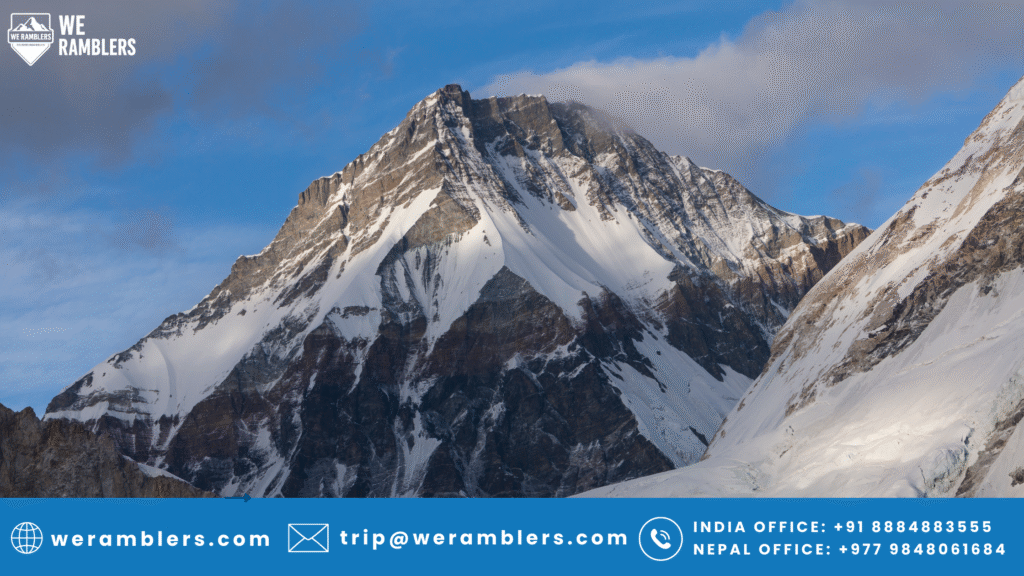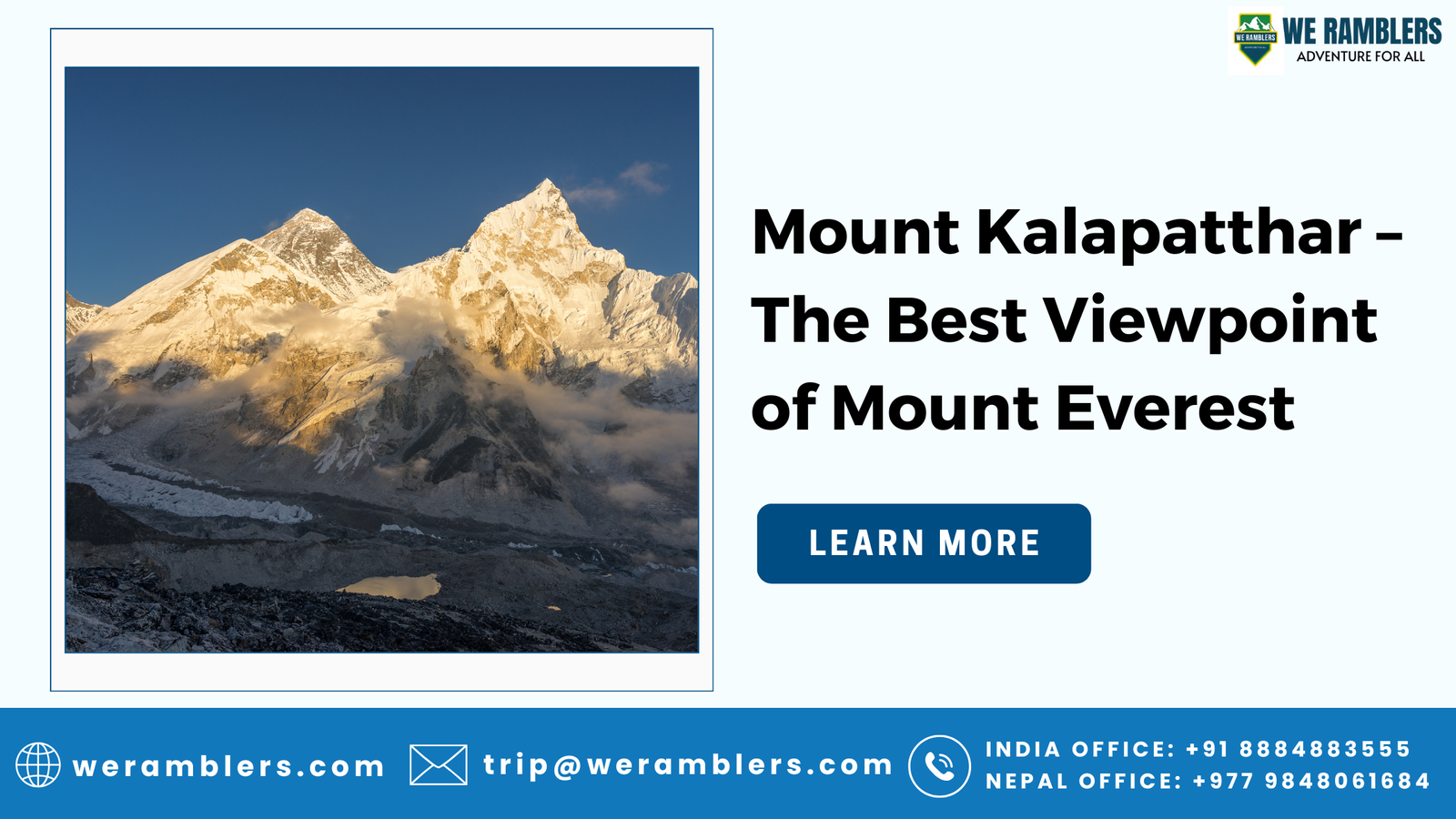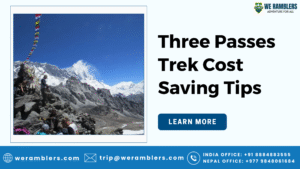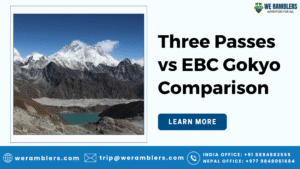Mount Kalapatthar – The Best Viewpoint of Mount Everest
Nestled in the Khumbu region of Nepal, Mount Kalapatthar is one of the most iconic viewpoints in the Himalayas, offering a panoramic view of Mount Everest that even the Everest Base Camp itself can’t match. Known locally as “Kala Patthar,” meaning Black Rock in Nepali, this Himalayan trekking destination stands as a dream for adventurers seeking the ultimate mountain view.
From this vantage point, trekkers witness snow-capped peaks, glaciers, and the world’s tallest mountain in all its glory. With the Himalayan peaks of Nuptse, Lhotse, and Pumori surrounding you, the scenery feels surreal.
Whether you’re a seasoned trekker or a first-time visitor to the Everest region, Kala Patthar viewpoint offers an experience that’s as breathtaking as the altitude itself. It’s more than just a stop on the trail; it’s the moment where the Himalayan dream becomes reality.
Where is Mount Kalapatthar Located?
Mount Kalapatthar lies in the Khumbu region of Nepal, just above the small settlement of Gorakshep. It sits inside Sagarmatha National Park, a UNESCO World Heritage Site, and is part of the Everest Base Camp trek route.
This high-altitude point is strategically located for trekkers who want to witness Mount Everest without obstruction. While the Everest Base Camp offers proximity to the mountain, the actual summit of Everest isn’t fully visible from there due to Nuptse blocking part of the view. Kala Patthar, on the other hand, rises to a vantage point where the Everest massif is completely visible.
Reaching this spot is typically part of a longer trekking journey, and most trekkers climb Kala Patthar early in the morning or during sunset from Gorakshep. Its location makes it an unmissable highlight for those venturing deep into the Himalayan wilderness.
Why is Kala Patthar Famous?
Kala Patthar is world-famous as the best Everest viewpoint. From here, trekkers get a 360° Himalayan panorama that includes Mount Everest (8,849 m), Lhotse, Nuptse, Pumori, and even parts of the Khumbu Glacier.
One of the most magical experiences here is witnessing the sunrise over Everest. As the first rays of light hit the summit, the golden glow slowly spreads across the snow-covered peaks. The sunset views are equally captivating, painting the mountains in shades of pink and orange.
Another reason for its popularity is photography. The Everest photography spot at Kala Patthar is considered one of the best in the world. You can capture the mighty mountain without distortion or obstruction, a dream for photographers and travel bloggers alike.
It’s also a place where trekkers feel an emotional high, having climbed above 5,500 meters, breathing thin air, and standing among the giants of the Himalayas. For many, Kala Patthar becomes the emotional climax of their Everest trek.
Mount Kalapatthar Altitude & Difficulty Level
The altitude of Kala Patthar is approximately 5,545 meters (18,192 feet), making it one of the highest points trekkers can reach without technical climbing.
While the climb from Gorakshep to Kala Patthar is relatively short (about 1.5–2 hours), the thin air at this elevation makes it physically demanding. The trek is graded as moderate to challenging due to altitude gain and cold weather conditions.
Proper acclimatization is essential to avoid altitude sickness. Many trekkers include rest days in Namche Bazaar or Dingboche before attempting Kala Patthar.
Though no technical skills are needed, a good fitness level, layered clothing, and mental determination are key. You must be accompanied by a certified guide, who ensures safety, provides local knowledge, and assists in case of emergencies.
Best Time to Trek Kala Patthar
The best season for Everest trek and Kala Patthar hike is during spring (March–May) and autumn (September–November).
In spring, the weather is mild, skies are generally clear, and the trails are alive with blooming rhododendrons. This season also aligns with Everest climbing expeditions, adding an extra sense of excitement to the trek.
Autumn offers crisp mountain views after the monsoon rains have cleared the skies. The stable weather makes it perfect for capturing the Himalayan panorama from Kala Patthar.
Winter (December–February) is cold and can bring snow, making the trek more challenging. Summer (June–August) coincides with the monsoon season, bringing cloud cover and slippery trails, which may obscure mountain views.
For the most unobstructed Everest views, plan your trip in spring or autumn and always trek with a professional guide for safety.
Popular Treks that Include Kala Patthar
Several Everest trekking routes include Kala Patthar in their itineraries. The most popular is the Everest Base Camp trek, where the climb to Kala Patthar is typically scheduled after reaching Gorakshep.
Other treks featuring Kala Patthar include:
- Gokyo Lakes and Everest Base Camp Trek – Combines the serene turquoise Gokyo Lakes with the classic Everest route, offering varied landscapes.
- Three Passes Trek – A challenging circuit that covers Renjo La, Cho La, and Kongma La passes, with Kala Patthar as a highlight.
- Everest Panorama Trek (shorter route) – Doesn’t go all the way to base camp but can include a side trip to Kala Patthar.
These treks offer a mix of Himalayan culture, Sherpa villages, and stunning landscapes. Whether you choose a 12-day or 20-day route, Mount Kalapatthar remains the ultimate viewpoint for Everest lovers.

Things to See from Kala Patthar Summit
From the Kala Patthar summit, the view of Mount Everest is truly unmatched. You’ll see:
- Mount Everest in full glory
- Nuptse and Lhotse towering nearby
- Pumori’s sharp peak
- The Khumbu Icefall glistening in the sun
- Parts of the Khumbu Glacier stretching into the distance
At sunrise, the snow takes on golden and crimson hues. At sunset, the peaks turn pastel pink and deep orange. The Himalayan sunrise from Kala Patthar is one of the most magical experiences in Nepal.
Trekking Itinerary (Including Kala Patthar)
Here’s a typical Everest Base Camp with Kala Patthar itinerary:
- Day 1–2: Fly to Lukla, trek to Phakding and Namche Bazaar
- Day 3: Acclimatization day at Namche Bazaar
- Day 4–6: Trek via Tengboche, Dingboche, Lobuche
- Day 7: Reach Gorakshep, hike to Everest Base Camp
- Day 8: Early morning climb to Kala Patthar, return to Gorakshep, descend to Pheriche
- Day 9–11: Trek back to Lukla
- Day 12: Fly to Kathmandu
A certified guide is mandatory for this trek, ensuring safety and smooth logistics.
We Ramblers — Your Mount Kalapatthar Trekking Partner
We Ramblers is a trusted Himalayan adventure company specializing in guided treks across Nepal, including the Everest Base Camp with Kala Patthar. With experienced certified guides, sustainable practices, and a passion for mountain exploration, our dedicated team ensures a safe, memorable, and well-organized trekking experience. From arranging logistics to providing cultural insights, they make every Himalayan journey extraordinary.
Frequently Asked Questions (FAQs) About Mount Kalapatthar
Q1: What is the altitude of Mount Kalapatthar?
A: The altitude of Kala Patthar is about 5,545 meters (18,192 feet) above sea level.
Q2: Is Kala Patthar harder than Everest Base Camp?
A: While shorter, Kala Patthar is more physically demanding due to its steep ascent and high altitude.
Q3: Can I see Mount Everest from Kala Patthar?
A: Yes, Kala Patthar offers the best unobstructed view of Mount Everest.
Q4: How long does it take to climb Kala Patthar from Gorakshep?
A: The hike usually takes 1.5–2 hours from Gorakshep to the summit. Contact us now to get the full trek itinerary.





